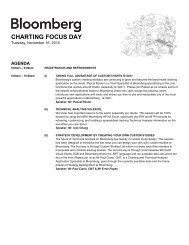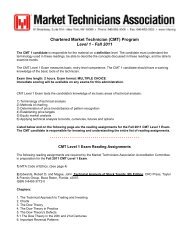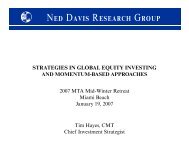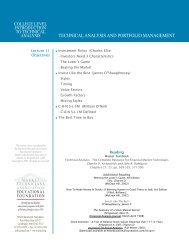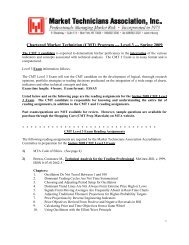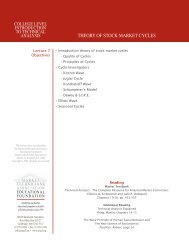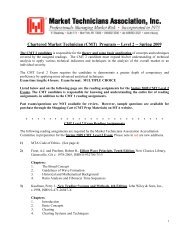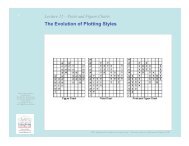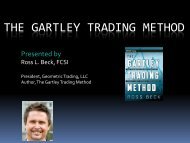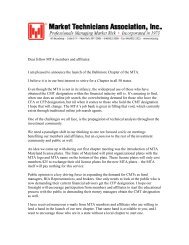Journal of Technical Analysis - Market Technicians Association
Journal of Technical Analysis - Market Technicians Association
Journal of Technical Analysis - Market Technicians Association
Create successful ePaper yourself
Turn your PDF publications into a flip-book with our unique Google optimized e-Paper software.
42<br />
Ichimoku Kinko Hyo<br />
Véronique Lashinski, CMT<br />
Goichi Hosoda, invented the cloud charts, or Ichimoku Kinko Hyo charts, in Japan before World War II. The method uses moving averages based on the middle<br />
<strong>of</strong> the range over a period <strong>of</strong> time, then shifts the lines, in the past and in the future.<br />
In this paper, we will compare hypothetical trading results in some US commodity futures markets, when using the base moving average crossover, with a few<br />
combinations <strong>of</strong> the different filters provided by the method.<br />
Outline Ichimoku Kinko Hyo on commodity futures<br />
I- Description/overview <strong>of</strong> the cloud lines, and basic trade signals derived from these lines.<br />
II- Tests.<br />
II-A Trade entry on Kijun Sen/Tanken Sen crossover, with no other condition. Exit on reverse Kijun Sen/Tenkan Sen crossover, with no other condition.<br />
II-B Trade entry on Kijun Sen/Tanken Sen crossover, adding both the Chikou Span and the cloud as filters. Exit when either condition no longer fulfilled.<br />
Conclusion: did the Chikou Span improve results?<br />
II-C Trade entry on Kijun Sen/Tanken Sen crossover, adding the market position relative to the cloud at the time <strong>of</strong> the signal as a filter. (above the cloud for buy,<br />
under the cloud for sell) Exit on reverse Kijun Sen/Tenkan Sen crossover, with no other condition.<br />
Conclusion: what is the impact <strong>of</strong> delaying the entry until the market position relative to the cloud confirms the outlook (above the cloud being bullish, and<br />
under the cloud, bearish)?<br />
II-D Trade entry on Kijun Sen/Tanken Sen crossover, adding the market position relative to the cloud at the time <strong>of</strong> the signal as a filter. (under the cloud for buy,<br />
above the cloud for sell) Exit on reverse Kijun Sen/Tenkan Sen crossover, with no other condition.<br />
Conclusion: does an aggressive entry, attempting to capture the move early make a difference?<br />
II-E Trade entry on Kijun Sen/Tanken Sen crossover, adding the Chikou Span as filter. (above the Chikou Span for buy, under the Chikou Span for sell) Exit on<br />
reverse Kijun Sen/Tenkan Sen crossover, with no other condition.<br />
II- F Trade entry on Kijun Sen/Tanken Sen crossover, adding the Chikou Span as filter. (above the Chikou Span for buy, under the Chikou Span for sell) Exit on<br />
reverse Kijun Sen/Tenkan Sen crossover, with no other condition.<br />
In this case, all lines are calculated with the original six-day week assumption.<br />
Conclusion: in the sample used, was it beneficial to have adapted the periods to the shorter working week?<br />
I Description/Overview<br />
Description/Overview <strong>of</strong> the cloud lines, and basic trade signals derived from these lines.<br />
I-A Overview<br />
A newspaper writer, Goichi Hosoda, invented the cloud charts, or Ichimoku Kinko Hyo charts, in Japan before World War II. The various lines are built from the<br />
middle <strong>of</strong> the range over different periods, with some <strong>of</strong> the lines shifted in the future. One more line is made using the close, plot in the past.<br />
Two <strong>of</strong> the lines are projected forward. The cloud is formed by the space between those two lines. As it is drawn in the future, it provides a unique, visual idea <strong>of</strong><br />
support and resistance in the future, not available in other techniques.<br />
This paper focuses on the five basic lines <strong>of</strong> the cloud chart, which are readily available in many charting systems. Using back testing, the author compares<br />
hypothetical results <strong>of</strong> trading systems based on the basic crossover in the method, using various combinations <strong>of</strong> the five lines, as added trade entry and/or exit filters.<br />
Hosoda’s original definitions were based on a six-day working week in Japan when he developed the method (which included more than the cloud charts presented<br />
below). As the author has adapted the cloud charts to a five-day working week in daily use, all the tests are based on the five-day working week assumption, except the<br />
last one, which uses the six-day working week.<br />
II-B Definitions <strong>of</strong> the Lines and Interpretations<br />
Tenkan-Sen/Turning line: (Highest high + lowest low)/2, for the past seven trading days. (nine trading days, in the case <strong>of</strong> the six-day working week<br />
environment) In other words, this is the middle <strong>of</strong> the range, over the past week and a half.<br />
Kijun-Sen/Base line: (Highest high + lowest low)/2, for the past 22 trading days. (The period is changed to 26 trading days, in the case <strong>of</strong> the six-day working<br />
week environment.)<br />
This is the middle <strong>of</strong> the range, but this time over the past month.<br />
Jo u r n a l <strong>of</strong> <strong>Technical</strong> <strong>Analysis</strong> • 2008 • Issue 65<br />
5




